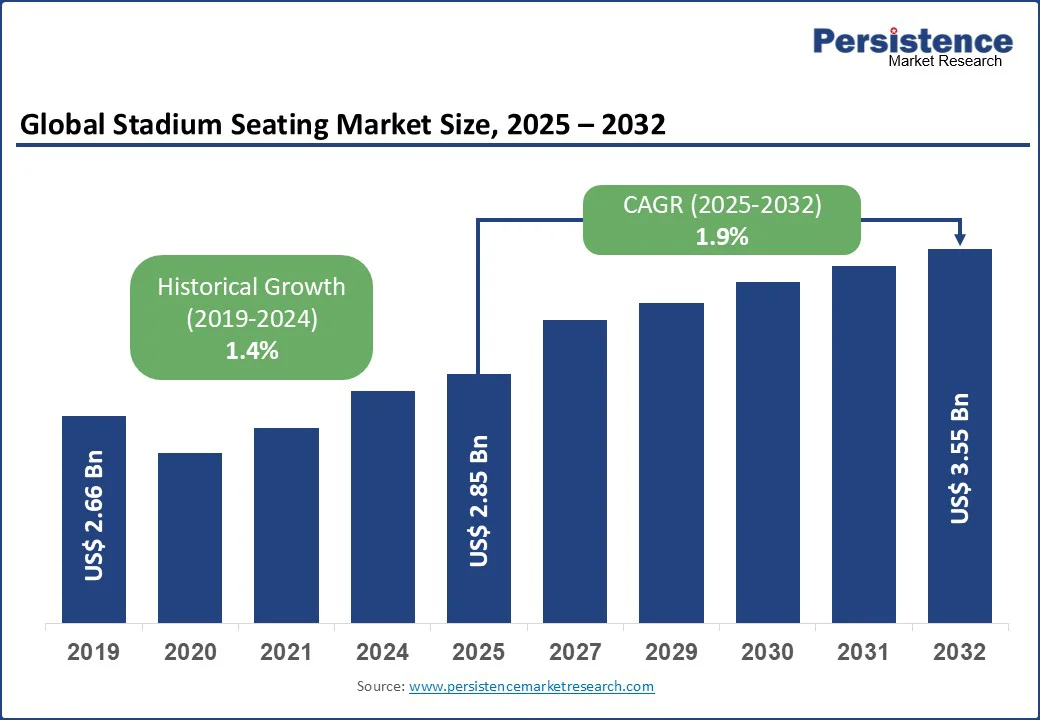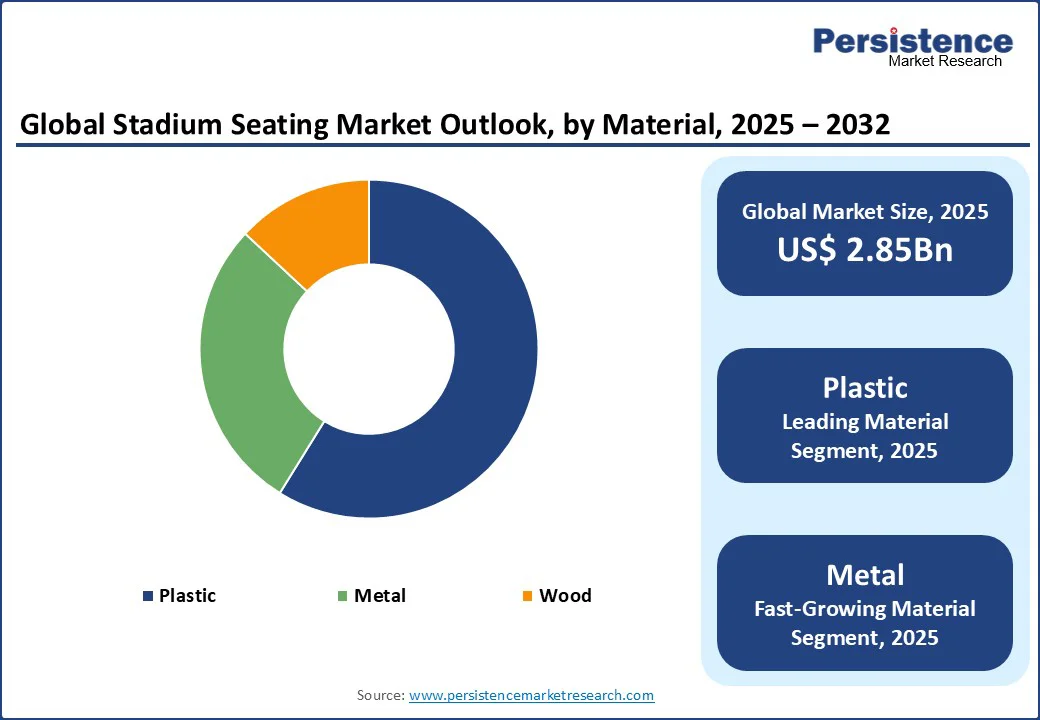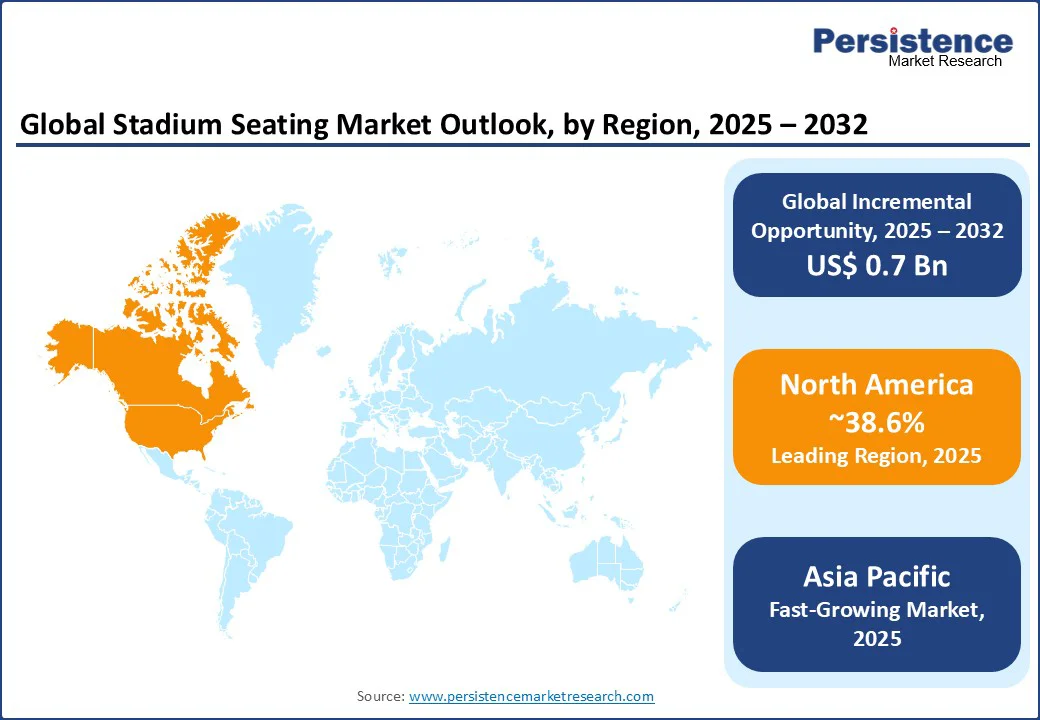ID: PMRREP34492| 179 Pages | 4 Sep 2025 | Format: PDF, Excel, PPT* | Consumer Goods

The global stadium seating market size is likely to be valued at US$2.85 Bn in 2025 and reach US$3.92 Bn by 2032, growing at a CAGR of 1.9% during the forecast period from 2025 to 2032.
The stadium seating market is experiencing robust growth, fueled by rising investments in sports infrastructure, urbanization, and increasing demand for advanced seating solutions in stadiums worldwide. Stadium seating, known for its durability, ergonomic design, and adaptability, is essential for enhancing spectator comfort and venue functionality. The surge in global sports events, coupled with advancements in seating technologies, supports market expansion.
Key Industry Highlights:

|
Global Market Attribute |
Key Insights |
|
Stadium Seating Market Size (2025E) |
US$ 2.85Bn |
|
Market Value Forecast (2032F) |
US$ 3.55Bn |
|
Projected Growth (CAGR 2025 to 2032) |
1.9% |
|
Historical Market Growth (CAGR 2019 to 2024) |
1.4% |
The global stadium seating market is experiencing robust growth, primarily driven by a surge in sports infrastructure investments worldwide. Governments and private sector players are heavily funding the construction of new stadiums and the renovation of existing facilities to meet the demand for hosting international sports events and enhancing spectator experiences. For instance, China’s investment in infrastructure for the 2022 Winter Olympics significantly boosted demand for advanced stadium seating solutions, reflecting the country’s commitment to world-class sports venues.
Urbanization trends and rising disposable incomes in emerging economies further fuel this growth, as more people attend live sports events seeking comfort and convenience. According to the National Sports Development Fund in India, government initiatives are channeling significant resources into upgrading sports facilities nationwide, thereby propelling demand for stadium seating. As sports infrastructure development intensifies globally, stadium seating remains a critical component, positioning the market for sustained expansion through 2032.
The stadium seating market faces notable restraints primarily due to high initial costs and ongoing maintenance challenges. Advanced seating options, such as telescopic and foldable designs, while offering flexibility and space efficiency, require substantial upfront investment. This financial barrier often discourages smaller venues and budget-constrained projects from adopting these modern solutions. For example, community sports facilities and smaller stadiums frequently opt for more affordable but less durable seating alternatives to manage limited capital expenditures.
Maintenance is another critical concern, especially for outdoor seating made from materials such as metal and wood. These materials are prone to weather-related deterioration, including rust, fading, and structural weakening, leading to high upkeep costs. These factors act as significant restraints, slowing down the stadium seating market’s overall expansion despite rising demand.
The increasing focus on sustainability and smart technologies presents significant opportunities for the stadium seating market. Eco-friendly materials, such as recycled plastic and sustainably sourced wood, are gaining traction as venues prioritize green initiatives. Smart seating systems, integrated with IoT for real-time occupancy tracking and comfort adjustments, are emerging in premium stadiums.
Companies such as Figueras are innovating with modular, sustainable seating for indoor stadiums, aligning with global sustainability trends. Government incentives, such as the EU’s Green Deal, encourage investments in eco-friendly infrastructure, creating opportunities for manufacturers to develop advanced, sustainable seating solutions to meet evolving industry needs through 2032.

North America dominates the stadium seating market, accounting for 38.6% of the stadium seating market share in 2025, driven by robust demand from stadium renovations and new sports facilities in the U.S. and Canada. Significant investments are being made in the construction of new stadiums and the renovation of existing ones. For instance, the 2026 FIFA World Cup, scheduled to be hosted across multiple U.S. cities, has prompted substantial upgrades to stadiums to meet international standards, including enhancements to seating arrangements. Canada’s growing sports tourism sector drives demand for durable seating, per Destination Canada. Major players such as Hussey Seating Company and Irwin Seating Company dominate with extensive distribution networks, catering to projects such as NFL stadium renovations. Consumer preference for ergonomic, high-quality seating strengthens North America’s market position.
Asia Pacific is the fastest-growing region, fueled by rapid urbanization, sports infrastructure investments, and the hosting of global events in countries such as China and India. In India, the development of large-scale venues such as the Narendra Modi Stadium (132,000-seat capacity) now the world's largest cricket stadium, illustrates the country's commitment to world-class infrastructure and rising demand for adaptable seating. India’s preparations for the 2036 Olympic bid boost demand for advanced seating. The region’s sports and entertainment industries also contribute, with companies such as Kotobuki Seating Co., Ltd. and Shenzhen Yourease expanding their presence. Rising disposable incomes and government-led projects ensure the Asia Pacific’s market dominance through 2032.
Europe is the second fastest-growing region, driven by stringent safety regulations, rising demand in sports and entertainment sectors, and infrastructure development in countries such as Germany and France. In 2022, the EU sports sector comprised around 190,000 enterprises, generating €29 billion in value added and €60 billion in turnover, supporting demand for advanced seating in football and multi-purpose stadiums. Germany’s football culture and France’s hosting of major events such as the 2024 Olympics boost demand. Companies such as Figueras and Ferco Seating Systems innovate with sustainable, ergonomic seating to meet regulatory and consumer demands, driving market growth through 2032.

The global stadium seating market is highly competitive, characterized by a fragmented landscape with numerous domestic and international players. Leading companies, such as Avant Seating, Camatic Seating, and Kotobuki Seating Co., Ltd., dominate through extensive product portfolios and global distribution networks. Regional players such as Shenzhen Yourease focus on localized offerings in the Asia Pacific. Companies are investing in sustainable materials and smart seating technologies to enhance market share, driven by demand for high-performance solutions in sports and entertainment venues.
The Stadium Seating market is projected to reach US$2.85 Bn in 2025.
Growing sports infrastructure investments and demand for sustainable, ergonomic seating solutions are the key market drivers.
The Stadium Seating market is poised to witness a CAGR of 1.9% from 2025 to 2032.
The rising demand for sustainable and smart seating solutions is the key market opportunity.
Avant Seating, Camatic Seating, Kotobuki Seating Co., Ltd., and Hussey Seating Company are key market players.
|
Report Attribute |
Details |
|
Historical Data/Actuals |
2019 - 2024 |
|
Forecast Period |
2025 - 2032 |
|
Market Analysis |
Value: US$ Bn/Mn, Volume: As Applicable |
|
Geographical Coverage |
|
|
Segmental Coverage |
|
|
Competitive Analysis |
|
|
Report Highlights |
|
|
Customization and Pricing |
Available upon request |
By Material
By Seating Type
By Design
By Application
By Region
Delivery Timelines
For more information on this report and its delivery timelines please get in touch with our sales team.
About Author